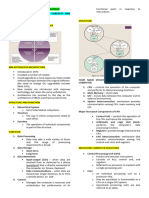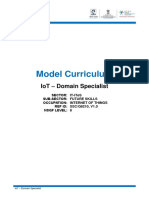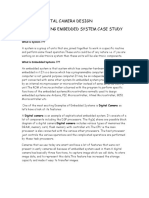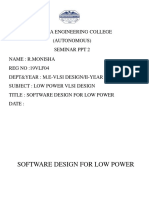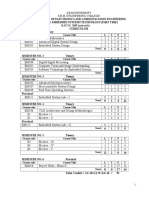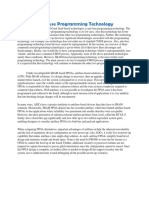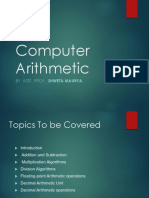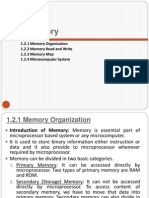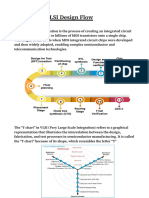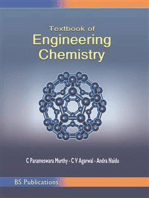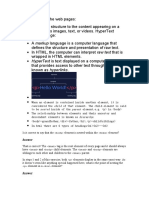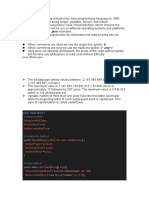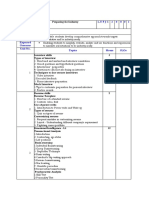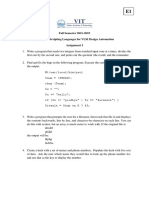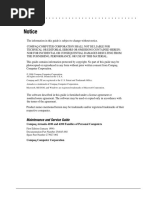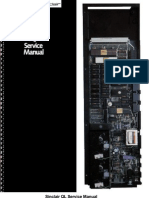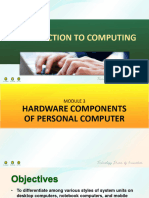0 ratings0% found this document useful (0 votes)
163 viewsEce5023 Memory-Design-And-testing TH 1.1 47 Ece5023
This document outlines the objectives, expected outcomes, modules, and evaluation of the course ECE5023 Memory Design and Testing. The course aims to cover the design of various memory technologies like SRAM, DRAM, NVRAM, and Flash. It will also cover memory testing patterns, design for test, reliability issues, radiation effects, and advanced memory technologies. The course outcomes include designing different memory types, developing testing patterns, incorporating testing techniques, improving reliability, and contributing to high performance memory subsystems. The course will be evaluated through continuous assessment tests, assignments, and a final assessment test.
Uploaded by
Bhargavi PatilCopyright
© © All Rights Reserved
Available Formats
Download as PDF, TXT or read online on Scribd
0 ratings0% found this document useful (0 votes)
163 viewsEce5023 Memory-Design-And-testing TH 1.1 47 Ece5023
This document outlines the objectives, expected outcomes, modules, and evaluation of the course ECE5023 Memory Design and Testing. The course aims to cover the design of various memory technologies like SRAM, DRAM, NVRAM, and Flash. It will also cover memory testing patterns, design for test, reliability issues, radiation effects, and advanced memory technologies. The course outcomes include designing different memory types, developing testing patterns, incorporating testing techniques, improving reliability, and contributing to high performance memory subsystems. The course will be evaluated through continuous assessment tests, assignments, and a final assessment test.
Uploaded by
Bhargavi PatilCopyright
© © All Rights Reserved
Available Formats
Download as PDF, TXT or read online on Scribd
You are on page 1/ 2
ECE5023 MEMORY DESIGN AND TESTING L T P J C
3 0 0 0 3
Pre-requisite Nil Version 1.1
Course Objectives :
The course is aimed at
1. Expounding the basics and detailed architecture of SRAMs and DRAMs.
2. model the memory fault and introduce the basic and advanced memory testing patterns.
3. Elaborate the reliability and radiation effect issues of semiconductor memories and present
methods for radiation hardening.
4. Review and discuss high performance memory subsystems, advanced memory
technologies and contemporary issues
Expected Course Outcome :
At the end of the course the student should be able to
1. Design SRAMs and DRAMs.
2. Design NVRAMs and Flash Memories.
3. Model memory faults, select suitable testing patterns and develop testing patterns.
4. Incorporate DFT and BIST techniques for semiconductor memory testing.
5. Improve the reliability of semiconductor memories, simulate and model radiation effects
and, perform radiation hardening.
6. Contribute to the development of high performance memory subsystems and use advanced
memory technologies.
Student Learning Outcomes (SLO): 1,6
1.Ability to apply mathematics and science in engineering applications.
6. Having an ability to design a component or a product applying all the relevant standards and
with realistic constraints.
Module:1 Volatile memories 5 hours
SRAM – SRAM Cell structures, MOS SRAM Architecture, MOS SRAM cell and peripheral
circuit operation, SOI technology, Advanced SRAM architectures and technologies, soft error
failure in SRAM, Application specific SRAMs, DRAM – DRAM technology development,
CMOS DRAM, DRAM cell theory and advanced cell structures, BICMOS DRAM, soft error
failure in DRAM, Advanced DRAM design and architecture, Application specific DRAM.
Module:2 Non-volatile memories 5hours
Masked ROMs, High density ROM, PROM, Bipolar ROM, CMOS PROMS, EPROM, Floating
gate EPROM cell, One time programmable EPROM, EEPROM, EEPROM technology and
architecture, Non-volatile SRAM, Flash Memories (EPROM or EEPROM), advanced Flash
memory architecture.
Module:3 Memory Testing and Patterns 7hours
General Fault Modeling – Read Disturb Fault Model – Precharge Faults – False Write Through
Data Retention Faults – Decoder Faults. Megabit DRAM Testing Nonvolatile Memory Modeling
and Testing-IDDQ Fault Modeling and Testing Application Specific Memory Testing – Zero/one
Pattern – Exhaustive Test Patterns – Walking, Matching and Galloping – Pseudo Random Pattern
– CAM pattern.
Module:4 Design For Test and BIST 4hours
RAM Built-In Self – Test (BIST)-Weak Write Test mode – Bit Line Contact Resistance – PFET
Test – Shadow Write and Shadow Read.
Module:5 Reliability and Radiation Effects 7hours
General Reliability Issues-RAM Failure Modes and Mechanism-Nonvolatile Memory Reliability-
Design for Reliability Radiation Effects-Single Event Phenomenon (SEP)- Radiation Hardening
Techniques Radiation Hardening Process and Design Issues-Radiation Hardened Memory
Characteristics.
Module:6 High-Performance Subsystem Memories 7hours
Hierarchical Memory Systems, Memory-Subsystem Technologies, High-Performance Standard
DRAMs, Embedded Memories.
Module:7 Advanced Memory Technologies 8hours
High-Density Memory Packaging Technologies, Ferroelectric Random Access Memories
(FRAMs)- Analog Memories-Magneto-resistive Random Access Memories (MRAMs)-
Experimental Memory Devices Memory Hybrids and MCMs (2D)- Memory Stacks and MCMs
(3D)-Memory MCM Testing and Reliability.
Module:8 Contemporary issues: 2 hours
Total Lecture hours: 45hours
Text Book(s)
1. A. K.Sharma, Advanced Semiconductor Memories: Architecture, Design and Applications,
John Wiley, 2014.
2. Roberto Gastaldi and Giovanni Campardo In Search of the Next Memory: Inside the Circuitry
from the Oldest to the Emerging Non-Volatile Memories, Springer, 2017.
Reference Books
1. Alberto Bosio, Luigi Dilillo, Patrick Girard, Serge Pravossoudovitch, Arnaud Virazel,
Advanced Test Methods for SRAMs: Effective Solutions for Dynamic Fault Detection in
Nanoscaled Technologies, Springer, 2010.
2. Hao Yu and YuhaoWang,Design Exploration of Emerging Nano-scale Non-volatile Memory,
Springer, 2014.
3. Takayuki Kawahara (Editor), Hiroyuki Mizuno (Editor), Green Computing with Emerging
Memory: Low-Power Computation for Social Innovation, Springer, 2012.
Mode of Evaluation:Continuous Assessment Test –I (CAT-I) , Continuous Assessment Test –II
(CAT-II), Seminar / Challenging Assignments / Completion of MOOC / Innovative ideas leading
to solutions for industrial problems, Final Assessment Test (FAT).
Approved by Academic Council No. 40 Date: 18.03.2016
You might also like
- Computer Architecture and Organization ReviewerNo ratings yetComputer Architecture and Organization Reviewer14 pages
- Cadence Layout Tutorial With Post Layout SimulationNo ratings yetCadence Layout Tutorial With Post Layout Simulation27 pages
- Module 3:the Memory System: Courtesy: Text Book: Carl Hamacher 5 EditionNo ratings yetModule 3:the Memory System: Courtesy: Text Book: Carl Hamacher 5 Edition73 pages
- An Introduction To Functional Verification of I2C Protocol Using UVMNo ratings yetAn Introduction To Functional Verification of I2C Protocol Using UVM5 pages
- Power Optimization For Low Power VLSI CircuitsNo ratings yetPower Optimization For Low Power VLSI Circuits4 pages
- Digital Signal Processors and Architectures (DSPA) Unit-2No ratings yetDigital Signal Processors and Architectures (DSPA) Unit-292 pages
- Exercises/Experiments Using Masm: Csl331: Microprocessor LABNo ratings yetExercises/Experiments Using Masm: Csl331: Microprocessor LAB11 pages
- Introduction To Cmos Vlsi Design: Silicon-on-Insulator (SOI)No ratings yetIntroduction To Cmos Vlsi Design: Silicon-on-Insulator (SOI)27 pages
- Password Protected Circuit Breaker: Audisankara Institute of TechnologyNo ratings yetPassword Protected Circuit Breaker: Audisankara Institute of Technology22 pages
- Lecture Notes: Microprocessors and MicrocontrollersNo ratings yetLecture Notes: Microprocessors and Microcontrollers217 pages
- Unit 3: Embedded Firmware & Hardware Design and Development100% (1)Unit 3: Embedded Firmware & Hardware Design and Development22 pages
- DR - Chao Tan, Carnegie Mellon University: Computer Organization Computer ArchitectureNo ratings yetDR - Chao Tan, Carnegie Mellon University: Computer Organization Computer Architecture221 pages
- Huge Question Bank For Microprocessor 8085 - 8085 Microprocessor Complete TutorialNo ratings yetHuge Question Bank For Microprocessor 8085 - 8085 Microprocessor Complete Tutorial20 pages
- 1.2 Memory: 1.2.1 Memory Organization 1.2.2 Memory Read and Write 1.2.3 Memory Map 1.2.4 Microcomputer SystemNo ratings yet1.2 Memory: 1.2.1 Memory Organization 1.2.2 Memory Read and Write 1.2.3 Memory Map 1.2.4 Microcomputer System37 pages
- Application-Specific Integrated Circuit ASIC A Complete GuideFrom EverandApplication-Specific Integrated Circuit ASIC A Complete GuideNo ratings yet
- Introduction to Internet & Web Technology: Internet & Web TechnologyFrom EverandIntroduction to Internet & Web Technology: Internet & Web TechnologyNo ratings yet
- Fundamentals, Linux/Unix Commands, Regular Expressions, Variables, VI EditorNo ratings yetFundamentals, Linux/Unix Commands, Regular Expressions, Variables, VI Editor12 pages
- This Is All Commented Console - Log (10) None of This Is Going To Run! Console - Log (99)No ratings yetThis Is All Commented Console - Log (10) None of This Is Going To Run! Console - Log (99)25 pages
- Mat5009 Advanced-Computer-Arithmetic TH 1.1 46 Mat50090% (1)Mat5009 Advanced-Computer-Arithmetic TH 1.1 46 Mat50092 pages
- Fall Semester 2021-2022 Scripting Languages For VLSI Design Automation LAB - 05 - PERL Regular ExpressionNo ratings yetFall Semester 2021-2022 Scripting Languages For VLSI Design Automation LAB - 05 - PERL Regular Expression5 pages
- STS5002 L T P J C 3 0 0 0 1 Course Pre-Requisites Objectives Expected Outcome Unit No. Topics Hours SlosNo ratings yetSTS5002 L T P J C 3 0 0 0 1 Course Pre-Requisites Objectives Expected Outcome Unit No. Topics Hours Slos3 pages
- Fall Semester 2021-2022 ECE5030 - Scripting Languages For VLSI Design Automation Assignment INo ratings yetFall Semester 2021-2022 ECE5030 - Scripting Languages For VLSI Design Automation Assignment I1 page
- Panasonic kx-ft982ls 984ls 988ls SM PDFNo ratings yetPanasonic kx-ft982ls 984ls 988ls SM PDF194 pages
- Integration of Novel 3D Structured Devices: Besang IncNo ratings yetIntegration of Novel 3D Structured Devices: Besang Inc30 pages
- Internal Memory: Presented By: SELINA YOUSAF ROLL NO: 0632-BH-MB-19 Section: H1No ratings yetInternal Memory: Presented By: SELINA YOUSAF ROLL NO: 0632-BH-MB-19 Section: H110 pages
- Sinclair QL Service Manual - Sinclair ResearchNo ratings yetSinclair QL Service Manual - Sinclair Research45 pages
- Types of RAM (Random Access Memory) : Information TechnologyNo ratings yetTypes of RAM (Random Access Memory) : Information Technology31 pages
- Electrical Memory Materials and Devices Wen-Chang Chen (Ed.) download100% (2)Electrical Memory Materials and Devices Wen-Chang Chen (Ed.) download84 pages
- Digital Circuits Questions and Answers - Demultiplexers (Data Distributors) - 2No ratings yetDigital Circuits Questions and Answers - Demultiplexers (Data Distributors) - 275 pages
- Introduction To Computing - Module 3 - Hardware Components of Personal ComputerNo ratings yetIntroduction To Computing - Module 3 - Hardware Components of Personal Computer42 pages
- BM3551 Embedded Systems and IoMT Lecture Notes 1100% (1)BM3551 Embedded Systems and IoMT Lecture Notes 1137 pages
- Embedded Memories Designs and ApplicationsNo ratings yetEmbedded Memories Designs and Applications70 pages
- 256x16 SRAM Design: CPEN115 - Computer System Architecture100% (1)256x16 SRAM Design: CPEN115 - Computer System Architecture7 pages
- Explain The Concept of Information TechnologyNo ratings yetExplain The Concept of Information Technology38 pages

